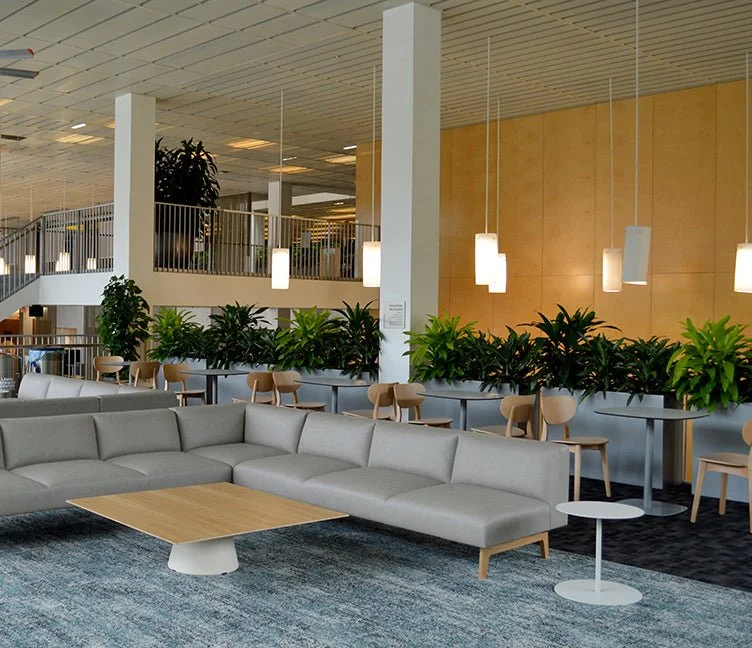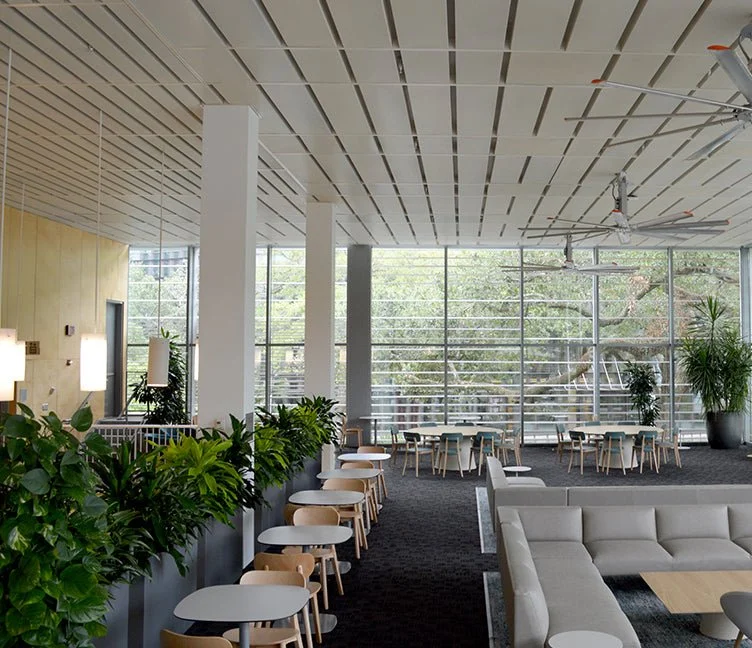4 Ways Campus Landscape Design Benefits Student Life
Campus landscape design can have a direct impact on how students perceive a college or university and, in turn, whether they invest their tuition dollars there.
University finance teams tend to overlook campus landscape design when considering how colleges and universities generate revenue. But the look, feel, and functionality of your campus can have a make-or-break impact on whether students choose to attend. And that choice has a significant impact on revenue generation.
Elevating campus landscape design can drastically affect how prospective and current students feel about a school. Research shows landscape design in academic settings can improve social interaction, mental health, and academic performance.
By taking a strategic approach to campus landscape design, you can improve campus culture and begin nurturing a more positive environment for your students.
PurePots Fiberglass Planters at Tulane University in New Orleans, LA
4 Benefits of Investing in Campus Landscape Design
Grassy quads with beautifully landscaped beds and gorgeous pots of vibrant plants are beloved components of college and university campuses all over the world. The campus landscape plays many important roles, including contributing to the overall student experience.
In fact, a strategically designed campus can promote a sense of community by providing areas for socialization, collaboration, and recreation, according to research from the University of Bonn, Germany. (1)
When students see an incredible campus that can enhance their overall experience, they’re more likely to invest their time and tuition dollars into attending that school.
Keep reading to learn about how campus landscape design can benefit your students and your bottom line.
Benefit #1: Boosting Student Performance
Studies have repeatedly shown that academic performance has a positive correlation with outdoor exposure that includes a high quantity of plants.
Just as natural light can boost employee productivity, students also benefit from learning in areas that are open and airy. Thoughtfully-designed outdoor spaces provide students with access to these benefits. (2)
Unfortunately, the opposite is also true. One study found that high schools with bleak, featureless landscapes including only athletic fields and parking lots had lower test scores. (3)
These studies prove that campus acreage alone is not enough to move the needle for student performance. Because aesthetics matter, campus landscaping must be strategically considered in order to deliver results.
PurePots Fiberglass Planters at Tulane University in New Orleans, LA
Benefit #2: Promoting Social Activities
As learning models change over time and technology spreads learning beyond the traditional four walls, students need more opportunities for socialization.
Impactful campus landscape designs provide areas that encourage students to interact with one another in a variety of ways. This is especially significant in 2023, considering the following:
During the pandemic, the average student was found to be spending nearly 80% of their waking hours in front of at a screen. (4)
As we approach a post-pandemic world, it’s increasingly important to create spaces that will get students out from behind their computers and interacting with one another face-to-face.
Given how critical college networking is for future career success, these social activities and interactions are proving to be increasingly important. (5)
Benefit #3: Improving Mental and Physical Health
Spending time outdoors has been known to lower stress levels and elevate moods. Now, more and more data suggests that time spent outside has lasting effects on other physical and emotional issues, including anxiety, depression, and even ADHD.
From an increase in vitamin D to reduced levels of noise pollution, a rejuvenated campus landscape complete with bright bursts of color can have a direct and significant impact on a student’s mental and physical health. (6)
This is all the more reason to create opportunities for students to be active on campus. Walking paths, biking trails, and outdoor fitness equipment will get students moving and can improve their overall physical health.
Benefit #4: Making Students Feel Welcome
Research shows that our survival mechanisms are “tuned to relax upon feeling the influence of certain patterns and symmetries characteristic of an accommodating environment." (7)
For many students, college is an emotional first experience away from home. “Surviving” in this new environment becomes easier when our environment is aesthetically pleasing and balanced — two very common features of a well-designed campus landscape.
A warm and inviting campus can help ease the transition away from family and friends and make students feel like they belong. This sense of community is integral to student success — both academically and socially.
PurePots Fiberglass Planters at Tulane University in New Orleans, LA
How to Achieve a Beautiful Campus Landscape
Providing open space isn't enough to create a significant impact on the student experience.
The layout, design, and features of the campus landscape are just as important as the greenery itself. Here are design features to incorporate when building a beautiful campus landscape that will have a transformative impact on your students.
Colorful Flowers
Specific colors have a positive effect on students' moods and emotions. Recent research shows that looking at yellow and red flowers for just a few minutes can cause a significant drop in stress levels. (8)
So, if your goal is to create a calm and inviting environment, consider using unique and visually-pleasing commercial planters to include some cheerful flowers in your campus landscape design.
Rain Gardens
A rain garden is designed to capture rainwater and allow it to slowly seep back into the ground. These gardens manage stormwater runoff while also providing an opportunity to add greenery to your campus.
Not only are rain gardens interesting, calming, and aesthetically pleasing, but they also minimize flooding and soil erosion. In addition, maintenance is minimal and the garden can also serve as a habitat for local wildlife.
Paths and Walkways
Don't just put a few stones down to take students from point A to point B. Instead, carefully consider the paths and walkways on your campus and how they can best be used:
Create a loop around the main academic building so that students have an easy way to get some exercise between classes.
Use winding paths to encourage exploration and discovery.
Lead the way to hidden gems on campus that students might not find otherwise.
Modular planters are a perfect solution when creating seamless walkways and paths for students. Because many planters are designed to fit together, they can be configured without gaps to produce the illusion of a cohesive extra-long container.
Don’t Forget About Indoor Landscapes
Bringing the outdoors inside is another important component of a great campus landscape design.
Indoor landscaping will completely change your university with the right type of plants, bringing some of the same benefits of outdoor exposure inside.
Commercial planters are a great way to achieve this, and they come in all shapes and sizes to fit any space. If you're looking for an easy way to add some life to your campus, decorating the spaces where students eat lunch is also a good idea.
Modern Elite Planters with casters at SUNY Cortland in Cortland, NY
Learn More
Understanding how campus landscape design affects student life — from their mood and performance to their sense of community — is critical for institutional success.
By investing in a well-designed landscape, colleges and universities can create a positive environment for their students to learn and thrive, in turn helping these institutions to increase their recruitment, retention, and revenues.
When you begin elevating your campus landscape design, consider incorporating high-quality commercial planters.
The key is to decide on size, color, and style needs first. And then select the material that best suits the aesthetic of your overall project.
If you’ve got questions about how to select or style the perfect planters for your unique project, request a quote today. Our experts will be happy to help you.
Sources:
(1). https://www.sciencedirect.com/science/article/pii/S2666558120300038
(3). https://www.sciencedirect.com/science/article/abs/pii/S0169204610001465
(5). https://www.linkedin.com/pulse/theres-art-career-networking-new-college-data-provides-george-anders/
(6). https://www.loveyourlandscape.org/benefits/the-benefits-of-landscapes/
(7). https://metropolismag.com/viewpoints/modernist-minimalism-and-our-relationship-with-our-buildings/























